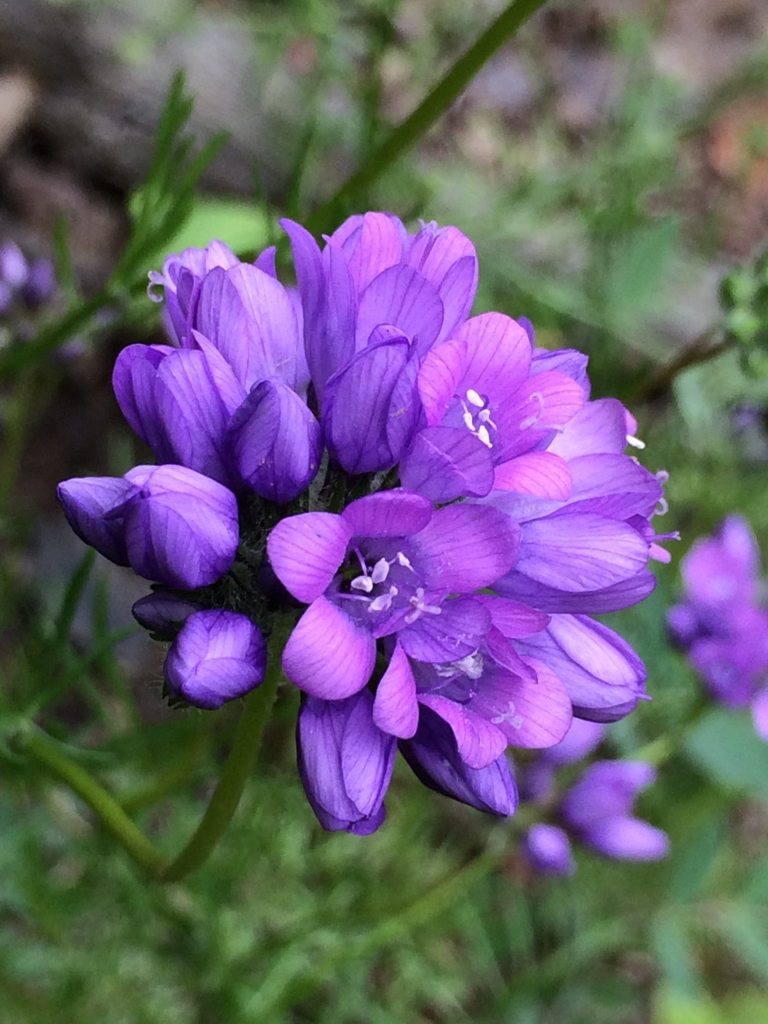In my last post I mentioned I writing a series about my favorite genera. Last week I did some plant surveys that included two rare Navarretia species, Navarretia paradoxinota

and Navarretia leucocephala ssp. pleiantha

I have taken photos of 17 of the species in this genus and it’s definitely a favorite of mine. But I gotta say, they are pretty tiny, can look fairly similar to each other, and part of their interest comes from things like spiky bracts and funky sepals that just don’t photograph super well (although check them out in this shot of Navarretia peninsularis, another rare one!)

Well It’s my blog, so I can break my own rules! Rather than just sticking with one genus, I’m going to expand to a whole plant family, the “5, 5, 5, 3, Polemoniaceae!” I’ll post my favorite photo from each of 10 genera.
If you want to become a better botanist, learning the common plant families in your area is definitely the way to do it. All plant families, of which there are about 450 globally, end in -aceae, and tend to have a recognizable look and shape, or gestalt. They also often have the same number of floral parts. Those parts are represented by a floral formula–which indicate, in order, the number of sepals (5 in the case of Polemoniaceae), petals (5), anthers (male parts, 5), and carpels (female parts 3). In this family the result is a memorable (to me, anyway) rhyming chant! You can see the characteristic number of petals, anthers, and carpels in this picture of the beautiful and very rare Polemonium chartaceum, an endemic to the White and Sweetwater Mountains.

For the carpel count, look at the three curling lobes of the stigma. While the numbers of other floral parts is fairly common in other dicot families, the three-lobed stigma is probably the easiest way to know you’re looking at a plant in the Polemoniaceae.
Families are then divided into genera (there are ~25 in Polemoniaceae), each of which have 1 or more species (~350 total in Polemoniaceae). All families have a type genus, after which they’re are named. The reason a taxa is chosen to be the type genus often has more to do with history than taxonomy. Polemonium is the type genus for this family because it’s the only one found in Europe, where plants got their binomials earlier. The only other genus in the family that’s found in the old world is Phlox, which makes it into Asia. My favorite phlox photo is this shot of Phlox dolichantha, another super rare plant, this time from the San Bernardinos.

The rest of the family, with a few South American exceptions, is found in Western North America. California alone has almost 200 species, well over half of the family’s total diversity. Of those, I’ve photographed 72. The inspiration for this post, Navarretia, is a perfect example of the diversification that’s occurred in the state, with something like 90% of the ~40 species found here. I’ll go with this shot of the delicate Navarretia filicaulis from the foothills of the Northern Sierras to represent this genus (those first three pics didn’t count!)

Many of the species in this family are typical of a life history strategy wildflowers employ when dealing with California’s unique climate. They tend to be annual plants that produce seeds without a dispersal mechanism. Instead, the seeds can remain dormant in the soil for a long time, waiting for a disturbance such as a wildfire, when they can germinate and bloom in huge numbers. Many species prefer gravelly (well drained) soils, do best in full sun, and bloom in spring, when days are long but there’s still moisture from the winter rains. Gilia, perhaps the most well known genus on account of its inclusion in many wildflower mixes, typifies the family. I’ll go with Gilia achelleifolia, a common plant from the South Coast Ranges, for this genus.

Gilia also are a clear example of speciation in action. Many of the 30 or so species in the state have numerous subspecies and varieties, among which reproductive barriers are beginning to develop. In fact, these plants caught the attention of Verne Grant, who conducted some amazing and foundational work in plant evolution on them.
While much of the diversity in this genus is found in the part of California with a Mediterranean climate, there are some great Polemones from the desert. Sunbonnets, Lanloisia setosissima,

and Desert Calico, Loeseliastrum matthewsii,

are some of my favorite components of the Mohave early spring bloom. The woolystars including this Eriastrum eremicum are also common desert annuals, although some of the species make it into other parts of the state

We’re getting some funky bilateral symmetry in these last two, but the floral formula (5,5,5,3) still holds.
Rather than the desert, other species are found in gravelly places high in the mountains. That includes Polemonium as well as the genus Ipomopsis, including Ipomopsis congesta.

I’ll return the heart of the California Floristic Provence for my last three pics. Here’s Collomia diversifolia, a serpentine specialist from the North Coast Ranges,

Linanthus killipii, an extremely rare plant from the Pinyon/Juniper woodlands around Baldwin Lake,

and, finally, Leptosiphon dichotomus.

This last one isn’t rare. And it’s certainly isn’t my best photography work, but it was necessarily taken in low light. This species closes its flowers during the day. With its low growth form and linear leaves, it is very hard to find until dusk, when it opens its large white flowers for hawkmoths to find. Like many species of the family it tends to grow in large, dense patches. Therefore when it does open, it’s easy to see the inspiration for its poetic common name, evening snow. These amazing displays make Linanthus dichotomus maybe my favorite Polemoniaceae species–and in a family this cool, that’s very high praise, indeed.